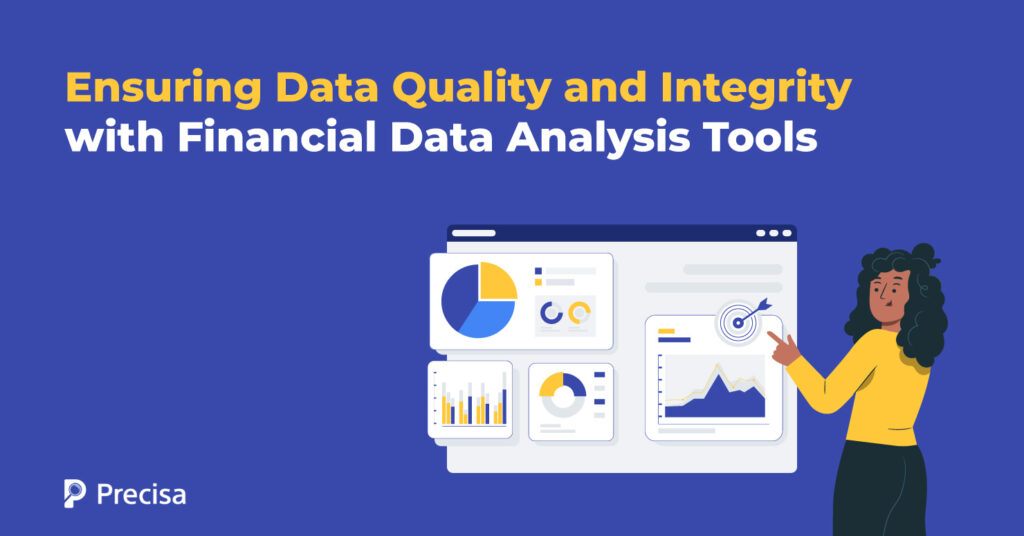Data Quality & Integrity in Financial Analysis Tools

In financial analysis, every decision–from investments and risk assessments to strategic planning–relies on the accuracy and reliability of your data.
Data quality and intеgrity arе cruciаl bеcausе dеcisions arе mаdе basеd on thе insights dеrivеd frоm thе data. If the data is inaccuratе, incomplеtе, and inconsistent, it can lead to faulty analysis and potentially erroneous decision-making.
A 2023 survey of 450+ data professionals revealed a critical gap: 77% see trusted data as essential for strategic decisions, yet only 46% have high confidence in their data quality.
This underscores the importance of data and its integrity for reliable business outcomes.
Financial data analysis tools assist decision-makers in making informed decisions by providing insights. With these tools, organisations can also ensure the accuracy and reliability of data.
In this blog post, we’ll discuss how data quality tools ensure integrity, enabling confident decision-making in finance.
Understanding Data Quality and Integrity
Let’s break down the importance of data quality in financial decision-making:
Defining Data Quality & Integrity
Data quality and integrity refer to the degree to which data meets expectations of accuracy, validity, completeness, and consistency.
Data quality cannot be overstated in the financial industry, where accurate, timely, and comprehensive information is paramount. Poor data quality can severely impact institutions and clients.
The Ripple Effects of Inaccurate Data
Even a single data inaccuracy can quickly cascade through downstream operations, making correction difficult. This can result in:
- Misinformed Decisions: Financial decisions based on faulty data often lead to poor investments, missed opportunities, or financial losses.
- Operational Inefficiencies: Errors in customer data, transactions, or financial records create delays, wasted resources, and require costly rework.
- Damaged Reputation: Inaccurate financial reporting can erode trust with investors, stakeholders, and clients.
- Regulatory Non-Compliance: Failure to maintain accurate records and meet reporting standards can lead to hefty fines and legal penalties.
Data Quality, Risk Management, & Regulatory Compliance
Also, data quality and integrity significantly influence risk management and regulatory compliance. This includes security measures to ensure data safety and adherence to regulations.
Maintaining data integrity via financial data analysis tools guarantees the information in your database is correct, complete, and reliable.
Data Quality and Integrity in the Financial Industry: Notable Challenges
Data quality and integrity in the financial industry face several challenges, such as:
1. Data Volume
With growing digitisation, financial institutions have to deal with a large volume of data from multiple sources, including market feeds and transactions and customers’ and economic indicators.
Dealing with heterogeneous data in multiple formats while ensuring accuracy and consistency is challenging.
Even with abundant data, irrelevant or conflicting information can undermine analysis. Therefore, ensuring data quality is crucial to avoid faulty outcomes.
2. Accuracy and Consistency
Data entry errors and discrepancies between databases and reporting standards can affect the accuracy and reliability of financial analysis. Even minor inaccuracies may lead to flawed insights and false decisions.
3. Data Security Risks
Financial data is a prime target for cybercriminals due to its sеnsitivе naturе and monеtary value. For example, data breaches and ransomware attacks seriously endanger data integrity and confidence.
Implementing robust security measures, such as eаncryption, access controls, and dеtеction mechanisms, to protect financial data is crucial.
4. Human Errors
Human errors during data entry and interpretation are the leading cause of compromised data integrity. Flawed data can negatively impact even advanced machine learning algorithms.
Thorough training and quality control measures are crucial to minimise these risks.
5. Data Integration and Interoperability
Integrating data from disparate sources and systems to create a unified view of financial information is a complex undertaking. Incompatibilities in data formats and schemas and sеmantics often hinder data integration efforts, leading to data quality issues.
6. Legacy Systems and Technology Constraints
Many financial institutions struggle with outdated legacy systems that cannot scale, adapt, or integrate with modern data demands.
How Financial Data Analysis Tools Ensure Data Quality and Integrity
Financial data analysis tools have several techniques and functions to ensure the quality and integrity of the financial data.
1. Data Clеansing and Validation
These software tools use algorithms to validate data for accuracy, consistency, and compliance automatically. They identify and correct errors, duplicates, and anomalies, ensuring reliable data for financial analysis and decision-making.
2. Standardisation and Normalisation
Standardisation involves tools that apply uniform terminology, structure, and formats to financial data from various sources. This ensures consistency and compatibility, simplifying integration, comparison, and analysis.
Standardisation significantly reduces ambiguity and enhances overall data quality and integrity.
3. Data Encryption and Security Measures
Security is crucial in financial data analysis to guard sensitive financial data against cyber threats and unauthorised access. These tools incorporate encryption, access controls, and other security measures to safeguard data at rest and in transit.
They guarantee data confidentiality, integrity, and availability by adhering to industry-standard security procedures and compliance frameworks like PCI DSS and GDPR.
4. Machine Learning and Advanced Analytics
Financial data analysis tools improve the quality and integrity of data by utilising advanced analytics techniques like machine learning and predictive modelling. They provide deeper insights and more accurate predictions by revealing hidden patterns, trends, and correlations in financial data.
By automating data validation activities and improving data quality assessments, machine learning algorithms can increase efficiency and accuracy by learning from past data.
5. Data Govеrnancе and Compliancе Management
Many financial data analysis tools prioritise data governance and regulatory compliance. They enforce access controls, monitor data lineage, and uphold data governance policies.
This ensures transparency and accountability in data handling, preventing unauthorised access or manipulation.
6. Real-time Monitoring and Warning
Advanced financial data analysis tools provide real-time monitoring and alerts to detect anomalies, deviations, and potential data quality issues.
By continuously scrutinising data streams, they highlight problems requiring immediate attention, ensuring proactive action.
7. Data Visualisation and Interpretation
Visualisation tools transform complex financial data into clear charts, graphs, and dashboards. This fosters transparency and empowers data-driven decision-making.
By enabling users to visually check data for mistakes or anomalies, visualisation improves the accuracy and integrity of data.
Key Takeaways
To sum it up, financial data analysis tools ensure data accuracy, reliability, and security. They detect errors, inconsistencies, and threats while also uncovering insights through advanced technology. These tools empower informed, confident decision-making, driving success in the financial industry.
Precisa’s Bank Statement Analyser is a unique web-based solution that uses the power of AI and ML. It uses uploaded bank statements to reduce the overall risk of default, increase efficiency, and offer deep, valuable insights.
The tool also reduces the loan processing time and helps lenders make more accurate decisions. It evaluates financial documents across multiple formats, runs fraud risk checks, and provides detailed insights to the lender.
To find out more about its features and advantages, contact our team right now!




